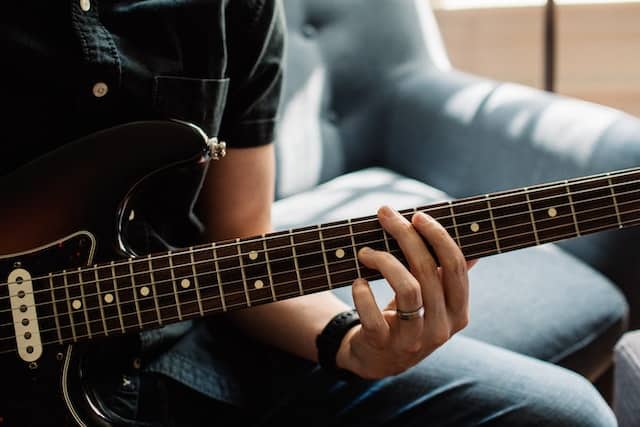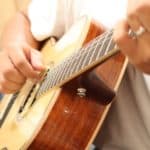Guitarists have a major superpower that other instruments don’t have. We can play chords. Lots of them.
With different tonal variations between chords with the same pitches.
Having all of this at our fingers does make us a force to be reckoned with!
There are many different ways to play a single chord on the guitar. This is due to the total number of pitches available on each string, allowing guitarists to play chords with the same pitches at various points of the neck. Also, the same chords in different positions have alternative sounds.
So, let’s dive into this subject.
A lot of this will be diving into some music theory, but we’ll try to explain what’s going on as best we can (also, it’s good for getting the musical brain muscles going!)
Before we begin…
A theoretical note: You’ll see references to what is known as “scientific pitch notation” (or SPN – C4, E4, etc.) This is a way of designating pitches based on their note, and where they fall on the standard 88-key piano (ie. middle C is C4).
On the guitar, what we typically learn as middle C is played at the 3rd fret of the fifth string (x 3 x x x x).
However, the pitch is actually C3 on the piano, making the guitar sound an octave lower than written.
This article will specify pitches in SPN on both instruments (so C4 on the guitar is the C at the first fret of the second string – x x x x 1 x), so if you try to play ideas on both instruments, the pitches and octaves will be the same.
Why are there many different ways of playing the same chord?
In the case of a piano, a root-position C major chord starting on middle C (C4, E4, and G4) can only be played one way, since those particular notes can only be found once on a piano.
Because of the number of frets on the guitar, certain pitches can be found in numerous places, making it possible to play the same pitches at different points on the neck.
So, the answer for that is just the sheer volume of places that notes can be played (and that’s just for one root-position chord!)
Do all positions for the same chord sound the same?
Every position can sound the same as far as notes are concerned, however, you will hear differences in tone.
Since thicker strings tend to vibrate differently than thinner ones, you will hear a distinctive “warmer” or “fatter” sound between a root-position E minor chord (E3, G3, and B3) between different string groups starting on:
- The sixth string – 12 10 9 x x x
- The fifth string – x 7 5 4 x x
- The fourth string – x x 2 0 0 x
You should hear the same pitches, but the tonal variations can be quite evident.
Is there a point in playing the same chord in different positions?
Of course!
First of all, there are tonal differences based on what string group you’re using.
Depending on what you’re playing, you may prefer a brighter-sounding version of a chord than a warmer-sounding one (or vice-versa)
Secondly, getting around the neck is much easier.
If you’re playing a tune, knowing where all your chords are means that you may be able to effortlessly stay in the same position and get all the chords you need, rather than sliding up and down the neck.
Why does the guitar have that many repeated notes?
The number of frets on a guitar has a lot to do with this.
In music theory, an octave (the distance between A and the next A on the instrument) has 12 semitones in it before it hits the following note (A, Bb, B, C, Db, D, Eb, E, F, Gb, G, Ab and finally A).
Now, let’s look at the guitar’s neck, which is divided into semitones (those frets!).
However, each string has between 21 and 24 frets, or 21 and 24 semitones (depending on the model of guitar you have; some have more frets than others).
This means that each string can span over an octave (and up to two, on a 24-fret neck).
However, all the strings are tuned a perfect fourth from each other (or major third between the G and B strings), so after five semitones (open string and frets 1, 2, 3, and 4 – or 1, 2, and 3 on the G string), you start repeating notes from the next string.
All of this is to say that a 24-fret neck on a guitar will span five octaves (from E2 to E5 on a piano, a total of 49 pitches).
However, there are also 150 notes on the fretboard (counting the open strings). So yeah, you got options!
Should you learn all the positions for a single chord on guitar?
Also yes!
Learning all those positions gives you a wide range of tonal options (warmer, brighter) and places where you can play those chords.
Just knowing a wide range of chords along can make you a more well-rounded musician, and your knowledge of the fretboard will be exponentially greater!
How many ways of playing a single chord are in the guitar?
Lots!
Let’s take a root position E minor chord (E, G, and B – let’s not worry about pitches) and just look at those three notes in that order.
Let’s also assume that you’re a shred god that only uses 24-fret necks.
Well..
- You can play that twice with the root on the sixth string (12 10 9 x x x, and 24 22 21 x x x)
- Or twice on the fifth string (x 7 5 3 x x, and x 19 17 16 x x)
- Or twice on the fourth string (x x 2 0 0 x, and x x 14 12 12 x)
- Or twice on the third string (x x x 9 8 7, and x x x 21 20 19)
Or what about the first inversion (G, B, E)?
- Also twice on the sixth string (3 2 2 x x x, and 15, 14, 14, x x x)
- Or the fifth (x 10 9 9 x x, and x 22, 21, 21 x x)
- Or the fourth ( x x 5 4 5 x, and x x 17 16 17 x)
- Or the third (0 0 0 x x x and 12 12 12 x x x)
Or how about the second inversion (B, E, G)?
- Twice on the sixth string (7 7 5 x x x, or 19 17 17 x x x)
- And the fifth (x 2 2 0 x x, and x 14 14 12 x x)
- And the fourth (x x 9 9 8 x, and x x 21 21 20 x)
- And the third (x x x 4 5 3, and x x x 16 17 15)
And that’s just a closed-position triad and it’s two inversions!
That’s 24 possible places for just those three notes in a closed-position chord!
We haven’t even looked at open-position (where the notes are more spread out), standard chords, barre chords, etc.
So, the answer is dozens!!
And it’s all useful knowledge!
The best way to learn all this is to pick a particular chord and figure out how many different places and ways you can play it on the neck.
The more you do, the more you’ll see the relationship between the strings and your fingers, and how those chords come about, making others easy to find.

Hello there, my name is Ramiro and I’ve been playing guitar for almost 20 years. I’m obsessed with everything gear-related and I thought it might be worth sharing it. From guitars, pedals, amps, and synths to studio gear and production tips, I hope you find what I post here useful, and I’ll try my best to keep it entertaining also.





